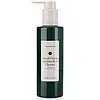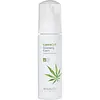What's inside
What's inside
 Key Ingredients
Key Ingredients

 Benefits
Benefits

 Concerns
Concerns

 Ingredients Side-by-side
Ingredients Side-by-side

Water
Skin ConditioningSodium Lauroyl Methyl Isethionate
CleansingGlycerin
HumectantAcrylates Copolymer
Cocamidopropyl Betaine
CleansingSodium Methyl Oleoyl Taurate
CleansingSodium Laurylglucosides Hydroxypropylsulfonate
CleansingSodium Cocoyl Isethionate
CleansingCitrus Aurantium Bergamia Fruit Oil
MaskingVerbena Officinalis Flower Extract
Skin ConditioningVetiveria Zizanoides Root Oil
MaskingSodium Ascorbyl Phosphate
AntioxidantPanthenol
Skin ConditioningAloe Barbadensis Leaf Juice
Skin ConditioningSodium Hydroxide
BufferingCitrus Glauca Fruit Extract
HumectantMicrocitrus Australasica Fruit Extract
Microcitrus Australis Fruit Extract
Skin ConditioningCamellia Sinensis Leaf Extract
AntimicrobialPanax Quinquefolius Root Extract
AstringentSodium Chloride
MaskingPhenoxyethanol
PreservativeCaprylyl Glycol
EmollientCitric Acid
BufferingPotassium Sorbate
PreservativeHexylene Glycol
EmulsifyingSodium Benzoate
MaskingWater, Sodium Lauroyl Methyl Isethionate, Glycerin, Acrylates Copolymer, Cocamidopropyl Betaine, Sodium Methyl Oleoyl Taurate, Sodium Laurylglucosides Hydroxypropylsulfonate, Sodium Cocoyl Isethionate, Citrus Aurantium Bergamia Fruit Oil, Verbena Officinalis Flower Extract, Vetiveria Zizanoides Root Oil, Sodium Ascorbyl Phosphate, Panthenol, Aloe Barbadensis Leaf Juice, Sodium Hydroxide, Citrus Glauca Fruit Extract, Microcitrus Australasica Fruit Extract, Microcitrus Australis Fruit Extract, Camellia Sinensis Leaf Extract, Panax Quinquefolius Root Extract, Sodium Chloride, Phenoxyethanol, Caprylyl Glycol, Citric Acid, Potassium Sorbate, Hexylene Glycol, Sodium Benzoate
Aloe Barbadensis Leaf Juice
Skin ConditioningWater
Skin ConditioningCocamidopropyl Betaine
CleansingGlycerin
HumectantSorbitol
HumectantSodium Methyl 2-Sulfolaurate
CleansingDisodium 2-Sulfolaurate
CleansingPanthenol
Skin ConditioningSodium Lauroyl Methyl Isethionate
CleansingSucrose Cocoate
EmulsifyingCannabis Sativa Seed Oil
EmollientMagnesium Ascorbyl Phosphate
AntioxidantCannabis Sativa Callus Culture Lysate Extract
Skin ConditioningResveratrol
AntioxidantAllantoin
Skin ConditioningTocopherol
AntioxidantLactic Acid
BufferingSodium Benzoate
MaskingPotassium Sorbate
PreservativeEthylhexylglycerin
Skin ConditioningCitrus Tangerina Peel Oil
MaskingCitrus Aurantium Flower Oil
PerfumingAnthemis Nobilis Flower Oil
MaskingAloe Barbadensis Leaf Juice, Water, Cocamidopropyl Betaine, Glycerin, Sorbitol, Sodium Methyl 2-Sulfolaurate, Disodium 2-Sulfolaurate, Panthenol, Sodium Lauroyl Methyl Isethionate, Sucrose Cocoate, Cannabis Sativa Seed Oil, Magnesium Ascorbyl Phosphate, Cannabis Sativa Callus Culture Lysate Extract, Resveratrol, Allantoin, Tocopherol, Lactic Acid, Sodium Benzoate, Potassium Sorbate, Ethylhexylglycerin, Citrus Tangerina Peel Oil, Citrus Aurantium Flower Oil, Anthemis Nobilis Flower Oil
Ingredients Explained
These ingredients are found in both products.
Ingredients higher up in an ingredient list are typically present in a larger amount.
Aloe Barbadensis Leaf Juice comes from leaves of the aloe plant. Aloe Barbadensis Leaf Juice is best known for helping to soothe sunburns. It is also anti-inflammatory, moisturizing, antiseptic, and can help heal wounds.
Aloe is packed with good stuff including Vitamins A, C, and E. These vitamins are antioxidants, which help fight free-radicals and the damage they may cause. Free-radicals are molecules that may damage your skin cells, such as pollution.
Aloe Barbadensis Leaf Juice also contains sugars. These sugars come in the form of monosaccharides and polysaccharides, folic acid, and choline. These sugars are able to help bind moisture to skin.
It also contains minerals such as calcium, 12 anthraquinones, fatty acids, amino acids, and Vitamin B12.
Learn more about Aloe Barbadensis Leaf JuiceCocamidopropyl Betaine is a fatty acid created by mixing similar compounds in coconut oil and dimethylaminopropylamine, a compound with two amino groups.
This ingredient is a surfactant and cleanser. It helps gather the dirt, pollutants, and other impurities in your skin to be washed away. It also helps thicken a product and make the texture more creamy.
Being created from coconut oil means Cocamidopropyl Betaine is hydrating for the skin.
While Cocamidopropyl Betaine was believed to be an allergen, a study from 2012 disproved this. It found two compounds in unpure Cocamidopropyl Betaine to be the irritants: aminoamide and 3-dimethylaminopropylamine. High-grade and pure Cocamidopropyl Betaine did not induce allergic reactions during this study.
Learn more about Cocamidopropyl BetaineGlycerin is already naturally found in your skin. It helps moisturize and protect your skin.
A study from 2016 found glycerin to be more effective as a humectant than AHAs and hyaluronic acid.
As a humectant, it helps the skin stay hydrated by pulling moisture to your skin. The low molecular weight of glycerin allows it to pull moisture into the deeper layers of your skin.
Hydrated skin improves your skin barrier; Your skin barrier helps protect against irritants and bacteria.
Glycerin has also been found to have antimicrobial and antiviral properties. Due to these properties, glycerin is often used in wound and burn treatments.
In cosmetics, glycerin is usually derived from plants such as soybean or palm. However, it can also be sourced from animals, such as tallow or animal fat.
This ingredient is organic, colorless, odorless, and non-toxic.
Glycerin is the name for this ingredient in American English. British English uses Glycerol/Glycerine.
Learn more about GlycerinPanthenol is a common ingredient that helps hydrate and soothe the skin. It is found naturally in our skin and hair.
There are two forms of panthenol: D and L.
D-panthenol is also known as dexpanthenol. Most cosmetics use dexpanthenol or a mixture of D and L-panthenol.
Panthenol is famous due to its ability to go deeper into the skin's layers. Using this ingredient has numerous pros (and no cons):
Like hyaluronic acid, panthenol is a humectant. Humectants are able to bind and hold large amounts of water to keep skin hydrated.
This ingredient works well for wound healing. It works by increasing tissue in the wound and helps close open wounds.
Once oxidized, panthenol converts to pantothenic acid. Panthothenic acid is found in all living cells.
This ingredient is also referred to as pro-vitamin B5.
Learn more about PanthenolPotassium Sorbate is a preservative used to prevent yeast and mold in products. It is commonly found in both cosmetic and food products.
This ingredient comes from potassium salt derived from sorbic acid. Sorbic acid is a natural antibiotic and effective against fungus.
Both potassium sorbate and sorbic acid can be found in baked goods, cheeses, dried meats, dried fruit, ice cream, pickles, wine, yogurt, and more.
You'll often find this ingredient used with other preservatives.
Learn more about Potassium SorbateSodium Benzoate is a preservative. It's used in both cosmetic and food products to inhibit the growth of mold and bacteria. It is typically produced synthetically.
Both the US FDA and EU Health Committee have approved the use of sodium benzoate. In the US, levels of 0.1% (of the total product) are allowed.
Sodium benzoate works as a preservative by inhibiting the growth of bacteria inside of cells. It prevents the cell from fermenting a type of sugar using an enzyme called phosphofructokinase.
It is the salt of benzoic acid. Foods containing sodium benzoate include soda, salad dressings, condiments, fruit juices, wines, and snack foods.
Studies for using ascorbic acid and sodium benzoate in cosmetics are lacking, especially in skincare routines with multiple steps.
We always recommend speaking with a professional, such as a dermatologist, if you have any concerns.
Learn more about Sodium BenzoateSodium Lauroyl Methyl Isethionate is a cleansing ingredient. It is a surfactant, meaning it helps gather dirt, oil, and other pollutants. This helps them be rinsed away easily.
Water. It's the most common cosmetic ingredient of all. You'll usually see it at the top of ingredient lists, meaning that it makes up the largest part of the product.
So why is it so popular? Water most often acts as a solvent - this means that it helps dissolve other ingredients into the formulation.
You'll also recognize water as that liquid we all need to stay alive. If you see this, drink a glass of water. Stay hydrated!
Learn more about Water